At Large on Islay
It rained hard my third night on Islay. I looked out the window early morning and thought it was yet another reason I would miss Rachel. I had to get around on my own for the next two days. But by the time I came down to the breakfast room at The Grange, it was clearing up outside.
Maggie made me the same breakfast every morning: orange juice, 1 egg, 1 rasher of bacon, GF toast and tea. (In case you aren’t familiar with bacon in the U.K., it’s more like what we would call ham and it’s very tasty.) After these breakfasts, I wasn’t usually hungry again until mid-afternoon. Harold chatted with the guests and we all heard about everyone’s adventures of the previous day. The Barrow-in-Furness brothers had left and in had come various young American couples and a jovial fellow from Burnley who was there to catch and release sharks for the fun of it.
Everyone had tales to tell about walking the Three Distilleries Pathway that begins just around the corner from The Grange. It’s a distance of three miles. The first half mile gets you to Laphroiag; a mile or so later, Lagavulin and at the very end, Ardbeg. Today was my day.
Harold gave me a lift to Laphroiag (pronounced la-froig) to get me started. A long time ago, Laphroiag distillery ran a hugely successful marketing campaign whereby you could own a square inch of the land. I don’t remember actually paying any money, I think there was just some official looking form to submit and I was sent a certificate saying I owned a piece of Laphroiag. I was at that time just starting to enjoy the scotches I referred to as “the smoky, peaty ones,” of which Laphroiag is one of the best.
Harold told me to collect my rent when I visited the distillery. I thought it was just one of his funnies but in fact if you tell them in the gift shop that you want to collect your rent, they give you a mini bottle stamped “rent paid!” They actually have the coordinates of the square inches catalogued and you can put a wee flag from your country on your square inch. I didn’t have any documentation with me but they said to put it anywhere I chose. Clearly this was a marketing scheme that became happily unmanageable.
The distillery is an impressive estate and squeaky clean as was Lagavulin up the road. I had a wee dram of lovely 19 year old Feis Ila in the comfort of the Lagavulin bar and mused about drinking whisky at 10:00 in the morning. Feis Ila is a scotch from the Caol Ila distillery, which I learned was owned by the same people as own Lagavulin.
Behind Lagavulin distillery on a little peninsula are the ruins of Dunyvaig Castle. I walked out to the ruin to get the iconic view of Lagavulin distillery.
The wind was blowing and the day was damp but it wasn’t cold. There would no doubt be more rain before too long but while on the footpath, I stayed dry. I enjoyed the sight and smell of the sea, the green grass, the enormous cows and the wonder that I had come such a long way to this island that I have wanted to see for so long.
Ardbeg was the end of the Three Distilleries Path. I had lunch, having been told I could get a “lovely lunch” in their café. I had thought I would curl up after that and have a wee dram and write but there wasn’t any place to do so. I said hello to one of the servers who lives down the road from The Grange and who has a cat named Bob. Then I walked out to the bus stop to wait for the bus that would take me back to Port Ellen.
It began to pour just after I got on the bus. This was to be my experience all the while I was in Scotland. I was generally aware that it was raining or had rained but I never got caught in it.
I explored Port Ellen. A post office shop called The Blue Letterbox, the Spar grocery shop (Spar is a chain of convenience shops), the Co-op, which seems to be everyone’s preferred place to buy groceries and down at the end of the high street, an old family-owned everything shop called Macaulay and Torrie. I walked down to the port and looked at the war memorial festooned with a wreath, poppy images and poppy-painted rocks.
Finally I ended up at the Islay Hotel for a cup of tea and a piece of cake.
The next morning I took the bus into Bowmore, the largest village on the island. I visited the round church at the top of Main Street, then called into the tourist center to get some help with my plan for the day. I wanted to explore Bowmore, go to the Islay Woolen Mills and have a leisurely lunch somewhere. Here was the plan we worked out:
Immediately: explore Bowmore for an hour and a half
12:39: Take the bus to Bridgend and have lunch in the Bridgend Hotel (They do a “lovely lunch.”)
2:50: Take the bus to the Woolen Mills, which are not a stop but the drivers (most of them anyway) will let you down there if you ask.
3:50: Stand on the edge of the road and flag down a bus to take you back to Bowmore.
At the Bowmore distillery I sweet-talked an 18 year old dram out of the bartender instead of the 10 year old they were offering as samples because I told him I could get that in Seattle. I had a good natter with Ron at the Celtic House, a book shop to die in. I wanted to buy every book I saw. Authors I’d never heard of, books about Islay and Jura, books Rachel had recommended.
Then I popped up to the tea room above the bookshop where I put in ear buds and found Bach’s Mass in B Minor on my phone. I was upping the volume the better to hear it when in my line of vision someone was waving at me and pointing to her ears. I took out my ear buds and she told me she didn’t think I was plugged into my phone. I could hear Bach all over the shop! I pushed the plug in firmly and the baritone voice stopped. Next to me two octogenarians were doing quite well whizzing around on their phones.
When I left I leaned into the woman who had signaled me and said “Technology is going to be the death of me.”
She laughed, “No worries!”
I caught an earlier bus to Bridgend with the same driver who had brought me to Bowmore earlier. When I finished my lovely lunch at the Bridgend Hotel I decided I would walk up the road to the Islay Estate. The road is two lanes and no shoulders but I was told that after a bit I would see a footpath. I never saw the footpath so I walked a mile up the road to the estate.
The Islay Estate was a kind of Downton Abbey affair back in the day of the Campbell Laird who owned it. In the yard which use to house the smiths and joiners and other professions necessary to keeping the lord and lady and their entitled children ensconced in their privilege there are now crafts-people and galleries. Several places were closed and the rest looked a little tired. I walked first in the kitchen garden, which was being put to bed for the winter. It must have been magnificent in its day. Then I visited with Elizabeth Sykes, a batik artist who is in the process of retiring and who Rachel had told me about. She made me the best cup of coffee I had had since I left Seattle.
“The Americans and the Germans all seem to like my coffee,” she said.
I went back to the main road, which I persist in calling the highway and confusing everyone because technically the main road is the low road. In the car park a big burly man with a red beard asked me if I was lost. I said I was hoping to flag down a bus to take me to the woolen mills.
“Hop in,” he said. “I’ll take you.”
His name was Rob. He was kind, drove very fast and talked non-stop. He left me at the top of the drive to the woolen mills and I followed the sound of rushing water until I came around a corner and entered the mill shop. An elderly man presiding at the counter asked me what I would like. I said I didn’t know, I had just come in the door.
“Well, look about!”
I looked about the gorgeous shop that smelled of wool and damp. In the back the looms were crashing away and I took a quick video while the weaver wasn’t looking, getting closer than I was technically allowed.
I noticed a portrait of a young man who could be no one other than the elderly man at the front counter, the owner, Gordon Covell. Another name I knew from Rachel’s tutelage. I introduced myself and said Rachel had told me about him.
I had to lean in to hear his thin voice say, “It wasn’t me. I wasn’t there.”
I burst out laughing.
At this point in my adventures, I was a mile from the nearest bus stop and it looked like rain. I went to the top of the road and hoped the bus I knew was coming would stop when I waved. It wasn’t the Islay bus I flagged down; it was a school bus. Evidently they will pick up anyone by the side of the road, too, so I rode into Bowmore on a school bus. I waited ten minutes in Bowmore for the bus to Port Ellen and once I was seated inside it started to rain.
At the Co-op in Port Ellen, I picked up some yogurt for the evening and found Margaret, my hostess, in the shop.
“Pop into the car—it’s the white one just across—and I’ll give you a ride up the hill.”
I popped in. I sat there uncomprehending for a bit thinking incredulously, “What is the steering wheel doing over here?”
I popped out and went around to the rider’s side. Margaret laughed when she got in the car; she had seen me. They could run a contest of the sighting of tourists getting into the wrong side of the car.
The wind was whipping up when I went to bed and I wondered if the water would be so wild in the morning that the ferry wouldn’t run. Stay tuned.
 RSS Feed
RSS Feed

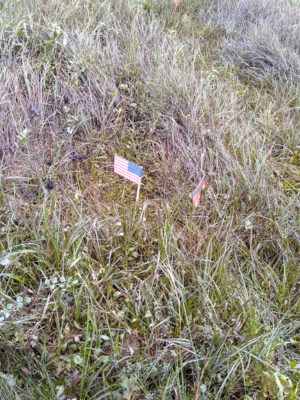
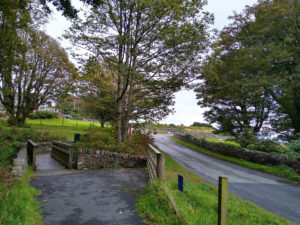
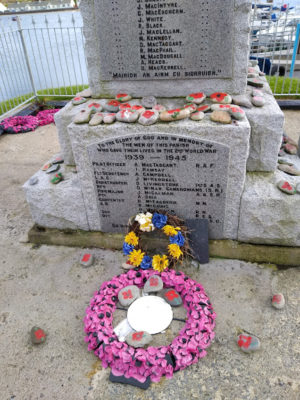
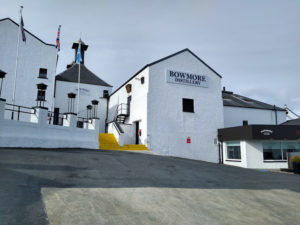
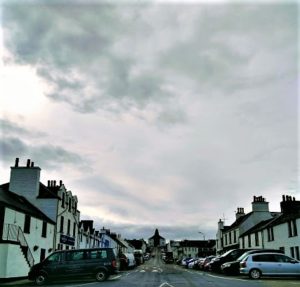
Good laugh over the headphones.
What do the Scottish consider “a lovely lunch “?
No idea. Pretty much anything is “lovely.”